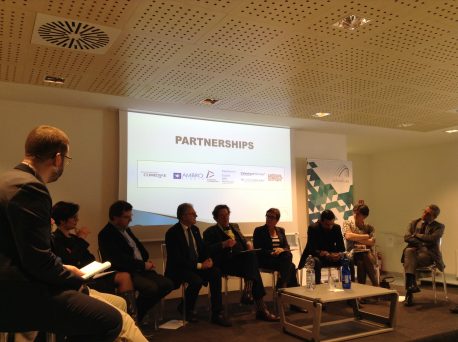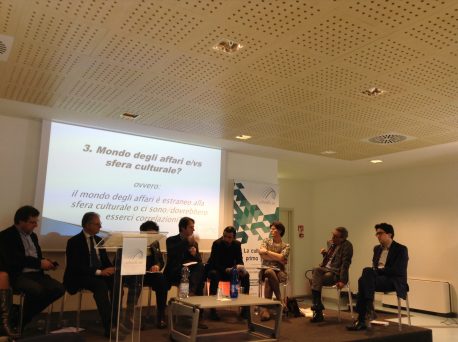On 25 March, EU leaders and civil society came together in the Italian capital to celebrate the 60th anniversary of the Treaties of Rome. Signed in 1957 by the six founding Member States, these treaties paved the way for the European Union that we know today: a continent of peace, founded on the values of solidarity, democracy, human rights and the rule of law; an attempt to organise a cultural life around a complex identity, not a hegemony of a single language, culture or religion.
After 60 years of existence, Europe is facing existential crisis. At a time of transition, great uncertainties and geopolitical upheavals, Europe needs to reinvent itself. But what’s next for Europe? ‘What future do we want for ourselves, for our children and for the Union?’ Does Juncker’s list of possible scenarios provide a solid vision on where we want to see ourselves in 60 years from now?
Rome last week became a real European capital. Politicians, civil society, intellectuals, students and youth from all over Europe came together to support Europe, calling for unity and change. Days preceding the EU summit were full of events, workshops, debates, round-tables and conferences aimed at mobilising the civil society and putting forward alternative scenarios for the future of the continent. Culture Action Europe was present in Rome and took part in various gatherings, highlighting a strong role of culture in achieving sustainable future of Europe.
“My future with YOUrope”
This interactive event organised by Civil Society Europe, looked in detail into 5 scenarios proposed by Juncker in the white paper (from the “minimalist” scenario to the “full-speed” option), discussed the pros and cons for citizens and organisations and possible other solutions. The first scenario was presented by Cristina Da Milano, board member of Culture Action Europe. Cristina regretted loudly that culture was not mentioned in this scenario (and neither in any of other four) and strongly supported that Europe should continue in 27. There are some other keywords that are forgotten in this scenario too. According to her, “the entire European society is missing” and the missing link with the society is the biggest problem of the European Union today.
Laura Sullivan from Action Aid International/CONCORD called the second scenario “ironic, ridiculous and dangerous” as it goes back to the worst parts that Europe can offer. She referred to the Bratislava declaration and roadmap section on migration that reads: “Never to allow return to uncontrolled flows of last year and further bring down number of irregular migrants and ensure full control of our external borders and get back to Schengen”. Laura highlighted that we need more Europe, stronger, united Europe to fight climate change, as climate doesn’t recognise the boarders. She worryingly emphasized that this scenario talks about keeping the single market for better free movement of capital and goods, however it completely forgets about the free movement of people.
Scenario #3 was presented from the perspective of the environmental organisation. Patrizia Heidegger from European Environmental Bureau (EEB) stated that issues that are close to the civil society: like human rights, social justice, environment, culture and youth do not at all feature prominently in the white paper. According to the third scenario, the EU27 proceeds as today but allows willing Member States to do more together in specific areas such as defence, internal security or social matters.
We’ve heard about “doing less more effectively”, or the fourth scenario from François Balate of European Youth Forum, who stressed the importance of the participation of young people in debates on future of Europe. “If not with us, then with whom do you envision the future?”, he asked. Balate mentioned that “doing less more effectively” might sound like a perfect solution, however, it’s far from reality. According to the fourth scenario, Europe sets the list of policy priorities (border control, terrorism, cross-border communication services etc.) where it coordinates actions, while in other areas Europe doesn’t have much of a say.
Leonie Martin from JEF Europe called the fifth scenario simplistic and very biased. According to her, this scenario might look like a plausible one, however, it is not detailed enough. “The white paper uses language very strategically”, she said, and called for the SCOs and citizens to take the challenge from the EC and get actively involved in the process of reflection on the future of Europe.
Lively discussion that followed these presentations showed the urgency of better coordination and faster mobilisation of the civil society organisations. Cross-sectoral miscommunication among the SCOs was mentioned as a challenge as well. The question of “who is the audience of the White Paper?” was also raised. The general feeling was that it does not address Member States, neither the SCOs, but rather has a pedagogical aim.
Culture Action Europe took this opportunity to invite different SCO representatives gathered in La Sapienza university in the reflection exercise to define a concrete proposal on what could be the role of culture in the future of the EU, understand which of the proposed scenarios CAE members approve or reject and perhaps most importantly, envision how the 6th scenario, where culture is an integral part, could look like.
“Can culture save Europe?”
The debate organised by cuturally.eu (Culture Action Europe among its partners), had the question of “transition towards what Europe?” “What’s the role of culture in envisioning other Europe?” at the core. Thousands of articles analyse the angst and turbulence of the world we are experiencing today, offering theories for the cause of today’s disruption, and (fewer) solutions and visions for a new future. Many conflict, yet some common ground is emerging. It seems everyone agrees the institutional arrangements – certainly in the EU but probably of the global order more widely – are not fit for purpose. It follows that what the EU really needs on its 60th birthday is not reform but reinvention.
Culture Action Europe’s Cristina Da Milano and Vice-Mayor of Rome and CAE former Secretary General Luca Bergamo talked about the importance of bringing cultural perspectives to the proposed scenarios and discussed the value of culture for human development, rather than economic development. CAE member Cumedia, represented by Ignasi Guardans agreed that this is not just an economic debate. It is through culture, and communication, that we could find answers to change the trend from global to local; or perhaps to turn them into something that creates a more constructive, and not confrontational, relationship between local and global; between local and European.


